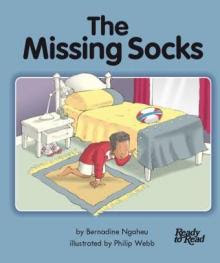The Missing Socks
0
Overview
Using this Resource
Connecting to the Curriculum
Marking Student Responses
Working with Students
Further Resources
This is about reading to find out what happens in a story.

Read the story "The Missing Socks" with another person.
Use the story to help you finish the sentences on the next pages.
Use the story to help you finish the sentences on the next pages.
Task administration:
This task can be completed online with some auto-marking.
Tasks a) to f) of this resource are marked online automatically. The tasks in g) and h) are open and students type in their responses so they are not marked automatically.
The resource is a shared activity, to be done by two students following a shared reading of the text "The Missing Socks".
Equipment: An audio version of the text is available on the Readalong 2012: Ready to Read and Junior Journal 44 and 45 CD as well as on an MP3 file at the Literacy Online link below.
Copyright:
Written by Bernadine Ngaheu and illustrated by Philip Webb, 2012.
Levels:
1, 2
Curriculum info:
Key Competencies:
Keywords:
Description of task:
After reading the text, students work on this resource with a partner, recalling the sequence of the story and some details. To do this, students are given a list of words to select from. Students justify their inferences based on the evidence in the written and visual texts.
Curriculum Links:
Links to the Literacy Learning Progressions for Reading:
This resource helps to identify students’ ability to use comprehension strategies as described in the Literacy Learning Progressions for Reading at: http://www.literacyprogressions.tki.org.nz/The-Structure-of-the-Progressions .
This resource helps to identify students’ ability to use comprehension strategies as described in the Literacy Learning Progressions for Reading at: http://www.literacyprogressions.tki.org.nz/The-Structure-of-the-Progressions .
Learning Progression Frameworks
This resource can provide evidence of learning associated with within the Reading Learning Progressions Frameworks.
Read more about the Learning Progressions Frameworks.Answers/responses:
Once students have completed the resource, tasks a) to f) are marked online automatically. The tasks in g) and h) are open and students type in their responses so they are not marked automatically.
Correct responses to all tasks are:
| a) | Dad; basket |
| b) | kitchen; Nana |
| c) | lounge; Mum; garage |
| d) | Noodles |
| e) | garage; kitchen; lounge; bedroom |
| f) | rugby socks; rugby boots |
| g) |
Possible responses to 'How did Noodles know where to find Jack's rugby socks?' include:
Jack's socks were stinky/ Noodles had a good sense of smell/ Noodles could smell them.
|
| h) |
Possible responses to 'How do you know this?' include:
The lines beside Noodle's nose show that he is smelling something./ The lines coming from the socks (or boots)./ The lines coming from the socks (or boots) show that they are stinky.
|
Trialled with Year 1 and 2 students.
Diagnostic and formative information:
Patterns of student responses from the trial of this resource with Year 1 and 2 students are:
a) In the first part of task a), most students did not correctly identify the missing word.
The majority of responses chose Mum, i.e., asking Mum first where something is. However, this story intentionally does not portray traditional roles amd stereotypes.
b) In the second part of task a), most students correctly identified the missing word.
The majority of students correctly linked the prior word 'washing' to the only appropriate word choice, i.e., 'basket'.
c) In task e), most students correctly identified the final missing word.
Even if students had not previously identified the correct order of places, the majority did correctly identify 'bedroom' as the final place that Noodles and Jack ended up in. The prior word, 'Jack's' would have been a strong cue for this.
d) In task g) most students made appropriate inferences.
Most students recognised Noodle's ability to smell. One student stepped out from the story to write: "because dogs can smell from far away".
e) In task h), many students had difficulty justifying their inferences.
Many students did not fully justify their inference in task g). Some students noted visual clues, e.g., "because Noodles was running at jack's rugby boots"; one student alluded to the visual clues, i.e., the lines coming from the socks, but not directly, e.g., "because they were smelly".
Next steps:
For students who do not identify details correctly:
For students who are having difficulty recalling details correctly, their attention needs to be drawn back to the text and the written and visual clues that it gives. Maybe before attempting this task online, students discuss with their partner the details of the story, e.g., what happened first, where did this happen, what happened second, where did this happen, etc. In their pairs, students should actively encourage each other to go back to the text. For example, one person be "the investigator" and say to their partner, "Show me where in the story it says/shows this".
For students who have difficulty justifying their inferences.
Here again, in their pairs, students can "investigate" each other, asking "Where is your evidence for thinking this? Show me, please.". Remind students that evidence comes from both the written and the visual texts.
For similar resources based on Ready to Read books but at different levels:
"Shoes for the King", levelled at Red 3. Shoes for the King
"Treasure Island", levelled at Green 1. Treasure Island III
"The Lion and the Mouse", levelled at Purple. The Lion and the Mouse
For other Level 1 resources that encourage reading in order to make meaning and to make inferences:

